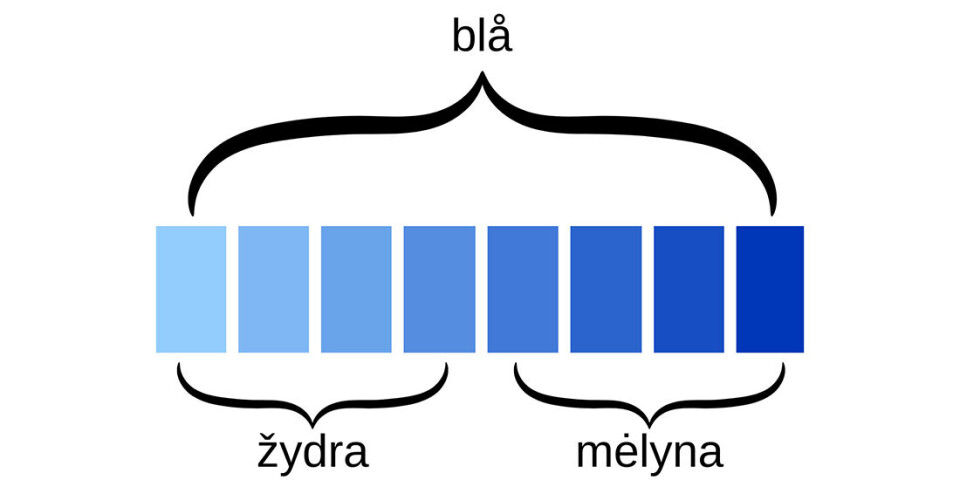THIS CONTENT IS BROUGHT TO YOU BY NTNU Norwegian University of Science and Technology - read more

Language affects how quickly we perceive shades of colour
Those who speak a language with multiple words for different shades of colour perceive these shades more quickly.
Bees have a phenomenal ability to perceive different shades of colour. Their eyes are able to see ultraviolet light, which helps them find flowers that produce nectar.

Human beings are also influenced by colours and different shades of colours. For example, we use different colours to create different moods in rooms. On signs, colours are used to send signals to the brain’s ability to perceive and interpret. If a sign has a lot of red on it, you should be extra cautious as there may be danger if you do not follow the sign’s instructions.
At sea, there are clear colour codes on pennants and maritime signal flags. For instance, it is a good idea to keep a certain distance from ships with a yellow flag on its mast; this is the colour code for contagious disease or quarantine.
More words for blue
Researchers have long been interested in how language affects our perception of the world. A fascinating aspect of this is how we perceive colours. Researchers at NTNU and the University of Oslo have investigated how language affects our perception of shades of various colours.
The human eye’s perception of colours is determined by its biology and is based on the perception of light. However, the colour spectrum is divided and defined differently across different languages.
For instance, Russian has two words for blue: ‘siniy’ for dark blue and ‘goluboy’ for light blue. English only has only one word: ‘blue.' Previous studies have shown that Russian speakers can distinguish between light and dark blue faster than English speakers.
“A logical next question is to what extent does your mother tongue influence your categorisation of colours, which are otherwise perceived in an objective way due to the biology of the eye,” says language professor Mila Vulchanova at NTNU.

Dynamic interaction
In the recent study, researchers have further investigated this phenomenon by analysing how bilingualism affects colour perception.
They studied how individuals who speak both Lithuanian and Norwegian defined shades of colour through the two languages.
Lithuanian, like Russian, has two distinct words for blue: ‘žydra’ (light blue) and ‘mėlyna’ (dark blue). In Norwegian, there is only one word: ‘blå.'
“Our study revealed that the bilingual participants’ ability to distinguish between shades of colour was influenced by the language they used while performing the task," says Vulchanova.
These findings shed light on the dynamic interaction between language and perception, which is our understanding of sensory input.
In practical terms, this means that the brain responds quickly to the activated language, linking sensory impression to this language. This phenomenon is known as ‘code-switching’ in bilinguals. As soon as a language is activated, the entire language system is active, including words and concepts.
“Our results also refer to the dynamic link between language and cognition, the brain’s ability to receive, process, and express the information," she says.
Vulchanova explains that both new and previous research shows that this interaction is a two-way process: language influences cognitive categories, and cognitive mechanisms and categories influence language.
Close collaboration
Mila Vulchanova has conducted research on language, perception, and brain activity for many years, especially on phenomena related to bilingualism. Several of the research projects are conducted in collaboration with students and PhD candidates she supervises.

“The research reveals that the language being actively used by bilingual individuals can significantly affect their perception of colour. The findings show that the language you use can shape how you perceive the world, right down to basic colour perception," says Akvilė Sinkevičiūtė.
She participated in the study while still a master's student. Now, she is a PhD candidate at Northeastern University of London.
"Our research demonstrates the intricate connection between language and perception, highlighting the profound impact of linguistic context on basic cognitive processes,” she says.
Method: Defining shades of blue
Participants in the study were divided into three groups: monolingual Lithuanians, monolingual Norwegians, and individuals bilingual in Lithuanian and Norwegian. All performed a task in which they had to distinguish between different shades of blue on a scale of 1 to 20.
They performed the task both with and without active language use to express where on the colour scale the shade of blue they were to define was located.
This was done in Lithuanian for the Lithuanians, in Norwegian for the Norwegians, and both in Lithuanian and Norwegian for the bilingual participants.
The bilingual participants had started learning Norwegian sometime between the ages of 5 and 43. A total of 106 people participated in the study.

Results and conclusion
Bilingual participants: Lithuanian–Norwegian bilinguals showed a clear colour category effect when performing the task in Lithuanian, but not when using Norwegian.
This means that they distinguished between light and dark blue faster when they were thinking in Lithuanian, and this advantage disappeared when they were thinking in Norwegian.
Monolingual participants: Monolingual Lithuanians also exhibited a colour category effect, while monolingual Norwegians did not. Lithuanians, with two words for blue, were quicker to define the different shades of blue than Norwegians who only have one word for blue.
“This supports the idea that the language we use can affect how we perceive colours – and that this link is very dynamic and dependent on the activation in the brain,” says Mila Vulchanova.
The study shows that the language we use can actively influence our perception of colours, also among bilingual people. When Lithuanian–Norwegian participants were thinking in Lithuanian, they had an advantage in distinguishing different shades of blue, which was not present when they were thinking in Norwegian.
“This suggests that language not only shapes how we communicate about colour, but also affects the colour categories that establish themselves in the brain during childhood – and that this can directly affect how we perceive shades of colour,” she says.
Reference:
Sinkevičiūtė et al. Active Language Modulates Color Perception in Bilinguals, Language Learning, vol. 74, 2024. DOI: 10.1111/lang.12645
More content from NTNU:
-
Why are pregnant women in Norway so worried?
-
Politics on Facebook: Populist parties choose divisive issues on purpose
-
Social media is connected to cyberbullying – but not how we thought
-
Forskere ved NTNU får nesten 24 millioner av EU for å lage nye strømomformere
-
This helps the youngest children enjoy school more
-
Can we tap the ocean’s power to capture carbon?





































